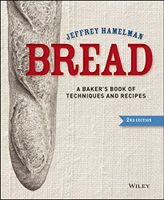Advertisement
Preface
Published 2004
The merest of ingredients are required, and these few are easily procured, requiring little intricacy in their preparation. And since so few ingredients are needed or necessary to the bread baker, from one bake to the next not much seems to change. One style of mixer suffices and can mix a full range of doughs. Some couche linens, a few stacks of proofing baskets, a decent scale, a durable work table, a couple of razor blades stuck on slender lames, and a sturdy oven: The needs are few. And yet from the time the grain is planted until baked bread is on the table, the hands and skills of dozens of people have been engaged. Farmers in the field plow, plant, cultivate, and harvest. Grain is transported to the mill to be tempered, ground, sifted, analyzed, and bagged—brought from berry to flour. Flour in the bag is trucked and hefted to the domain of the baker. Here the final magic is performed, for the flour is nothing by itself—it needs the baker to bring it to fulfillment, to coax all the flavor he or she can from the inert grain. The flour, unable to sustain life on its own, is transformed by the hands of the baker into wondrous bread, nurturing and nourishing. What we hold in our hands, months after the original planting of the seed, is the final resolution of the labor of many: a loaf of bread—ephemeral, fragrant, alive.

